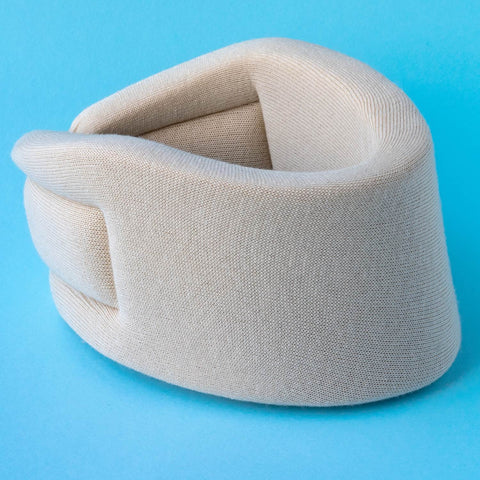Sleeping with a neck brace or cervical collar can be challenging, especially as you try to find a comfortable position that supports your head and reduces neck pain. Establishing the right bedtime routine and making adjustments to your sleeping environment play crucial roles in ensuring a restful night.
To improve comfort during sleep, ensure your neck brace is well-fitted and made of breathable materials. This helps to prevent skin irritation and overheating. Additionally, consider using a firm mattress and supportive pillows that align your head and spine correctly.
Most medical professionals recommend lying on your back as the best position for sleeping with a neck brace. This position maintains alignment and provides support. However, if back sleeping aggravates issues like snoring, side sleeping with proper support can be effective too. Just ensure your head, neck, and shoulders are appropriately aligned to prevent discomfort.
Preparing for Sleep
When preparing for sleep while wearing a neck brace, make sure that your mattress and pillow provide adequate support. Create an environment conducive to relaxation and comfort, minimizing any strain on your neck and ensuring a restful night.
Selecting the Right Mattress and Pillow
A supportive mattress is essential when sleeping with a neck brace. Opt for a mattress that maintains proper alignment of your spine, such as a memory foam mattress. This type of mattress contours to your body and reduces pressure points, offering improved comfort.
Choosing the right pillow is equally important. A cervical pillow is designed to support the natural curve of your neck. Look for pillows made from breathable materials to ensure comfort throughout the night. You may also consider using a memory foam pillow, which adapts to your specific alignment needs. Having a well-fitted neck brace and proper bedding can significantly decrease discomfort and enhance your sleep quality.
Setting Up Your Sleeping Environment
Establish a soothing sleeping environment to help you adapt to wearing a neck brace at night. Keep your bedroom cool and dark to promote better sleep. Reduce or eliminate smartphone and screen time at least two hours before bedtime to avoid unnecessary neck strain and stimulation.
Incorporate calming elements like white noise machines or melatonin supplements to facilitate a restful atmosphere. Ensure that your bedroom is free from clutter and distractions. Having a structured and calm bedtime routine can make it easier to fall asleep and stay asleep while wearing a neck brace, leading to a more restorative sleep experience.
Sleeping Positions and Techniques
When sleeping with a neck brace, proper positioning can significantly enhance comfort and aid the healing process. This involves choosing optimal sleeping positions and implementing techniques that ensure maximum support and stability for your neck and spine.
Back Sleeping with a Neck Brace
Back sleeping is often recommended for individuals with a neck brace as it evenly distributes weight and maintains a neutral position. To achieve the best results:
- Use a supportive pillow that aligns with the natural curve of your spine.
- Place a roll-up towel or a small cushion under your neck for added support.
- Ensure your head is not tilted too far back or forward to prevent additional strain on the neck muscles.
This position minimizes movement and helps avoid unnecessary twisting, promoting better pain management and preventing pressure sores. It’s also beneficial for those experiencing cervical pain or recovering from spinal fractures.
Side Sleeping Considerations
Although back sleeping is preferable, some find side sleeping more comfortable. If you choose this position:
- Pillow Height and Firmness: Choose a pillow that keeps your neck in line with the rest of your spine.
- Shoulder Positioning: Your shoulder should not be tucked under your body but lie comfortably on the mattress.
- Additional Support: A small pillow between your knees can help maintain proper spine alignment, reducing strain on the lower back.
These adjustments help ensure long-term use of the brace without compromising comfort during sleep. Be mindful of turning or twisting your neck, as this can counteract the support provided by the neck brace.
Additional Tips for Enhanced Comfort
- Sleeping Surface: Opt for a firm mattress to provide the necessary support for your body.
- Reclined Position: If lying flat is uncomfortable, consider a reclined position using a wedge pillow or an adjustable bed to keep your upper body slightly elevated.
- Monitoring for Pain: Observe any discomfort or pain in the neck and shoulders. Adjust your sleeping position or the support materials as needed.
- Avoid Stomach Sleeping: This position stresses your neck and should be avoided entirely.



